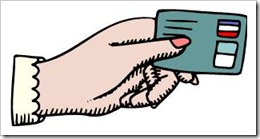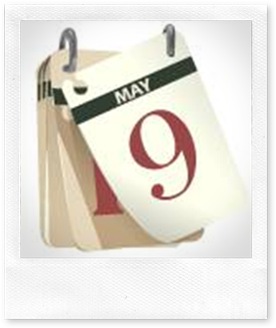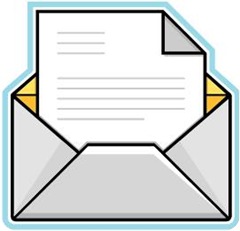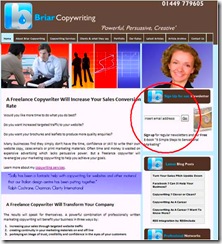Entries Tagged 'copywriting tips' ↓
February 3rd, 2010 — copywriter, copywriting tips, freelance copywriting, marketing
Everyday we are bombarded by an endless stream of marketing  messages. They are on the radio, TV even our cereal boxes so it’s little wonder that more and more of us are becoming increasingly cynical about marketing.
messages. They are on the radio, TV even our cereal boxes so it’s little wonder that more and more of us are becoming increasingly cynical about marketing.
People can spot hype a mile away and they don’t like it. If they think they’re being sold they’ll do their upmost to make sure they don’t buy.
Getting your sales message under their radar
Today, more than ever, copywriters and marketers are having to be more subtle about how they pitch to their audience.
It’s no longer the case that you can blast out an advert or sales letter and people will hand over their credit cards. Money’s tight, people are becoming more canny so you have to get clever.
6 ways you can market below radar
- Statistics – convert your marketing pitch into numbers. This will disguise it from those who think they can spot “sales speak” a mile off. Try something like “95% of dog owners reported a marked improvement in behaviour after following SITS training video”.
- Make the most of your pictures – pictures always add to your copy so make the most of them. If you add a picture you can be sure your reader will look for the caption, so make sure you give it to them. Rather than something lame like “Puddles hand cream 30ml” try something like “Puddles hand cream – used daily gives youthful, glowing skin”. Because the caption is describing the picture they assume it is the TRUTH.
- Testimonials – these work really well if they are attributed to someone your reader might have hear of. Then you get the “well if it’s good enough for them, it’s good enough for me” response.
- Case Studies – in a similar way to testimonials, case studies help add the ‘human’ sales angle. And people to love to hear real life stories.
- Frequently Asked Questions – whether you are a fan of these pages or not, they give the ideal opportunity to add more reasons why people should buy. For example if there is a question such as “What if SITS training course doesn’t work on my dog?” The answer would be “Not a problem as you are covered by our full money back guarantee.”
- Flattery will get you everywhere – cuddle up to your reader as you write to them. Make them feel special – share a secret with them – “Some people haven’t yet discovered SITS training plan. But as you and I know it’s worth the investment because a well trained dog is a happy dog.”
You product is amazing, you know that but you’ve got to get your reader to understand that too. But thanks to the many hyped up marketing messages around, your audience is growing increasingly sceptical.
By using these techniques you’ll slip under their “hype radar” so you can make your point and convince them you’re product is for them.
Sally Ormond – freelance copywriter
February 1st, 2010 — case studies, copywriter, copywriting, copywriting tips
Normally, when I talk to you about copywriting I hark on about how  important it is to write about the benefits of the product you are trying to sell.
important it is to write about the benefits of the product you are trying to sell.
That’s because benefits are the vital element to make your reader understand that you product is for them and so are a copywriter’s best friend.
However with the Case Study you have the prime opportunity to bring your benefits to life by dramatising them.
It’s not an easy road
Writing case studies isn’t easy, but the time and effort you spend honing them will be well worth it.
Testimonials are great, but case studies will carry more weight.
Why?
Because they are perceived as being truthful; you are telling your reader a story. Your case study will have a hero (your customer), a predicament (the problem they face), a narrative (what you did and why) and finally a happy ending.
So how can you be sure you write a compelling, interesting and relevant case study?
7 tips to creating a winning case study
Don’t make the mistake of thinking that writing a case study is simple. It isn’t. There are a lot of bad ones out there so I’ve put together a few tips for you to help you create a winner.
- Tell it from your customer’s perspective otherwise it will just come across as a piece of hype. Readers will be able to relate to your customer, after all they may well be facing the same problems. Let’s face it they probably are – if they weren’t why would they be reading your case study?
- Use real people in your photos if you can. Not everyone will be willing to do that but it adds weight to your case study if you can.
- Include as many facts and figures as you can. And give specific examples of what you did to solve their problem. Wishy-washy information will get you absolutely nowhere.
- People love pictures so use shots of your customers premises, machinery or whatever is relevant to your case study. This will add a sense of realism that you can’t achieve by using stock images.
- Let your client speak directly. Include plenty of relevant quotes and make sure you attribute them to the right person (including their full name and position). This is a great opportunity to present a new voice to your case study – try and use their language to add authenticity.
- Give it a good structure – a brief introduction to your customer, what their problem was, how you solved it, what the outcome was and future implications for them/their business.
- Make sure it is clear how they benefited from your product/service/expertise. This is crucial. If you tell your reader how your customer benefited they will associate that with how THEY will also benefit.
Now for things you don’t want in your case study
As I’ve already mentioned, your case study is your opportunity to prove to your readers that you can do something amazing.
If you want to sell something to a specific audience, you’ve got to prove to them they need it and that you’re good – very good.
Below are list of 4 elements you don’t want in your case study:
- A beginning that talks at length about your customer’s business. If you want to add information about their company, turnover or premises etc., put it in boxes at the side of your case study.
- Challenge and solution but without the results. Proof is the name of the game and without results you have proved absolutely nothing.
- No quotes. Your customer’s voice is essential. They need to speak to your reader and tell them precisely what you did for them and the results they have seen as a result.
- Dull narrative. Long words, complex sentences, excessive jargon, and an awkward flow create a boring case study. If no one wants to read it how can you prove yourself to them?
More and more people out there are taking an increasingly cynical view of “marketing speak”. Unsubstantiated claims are boring and damaging to your business.
People love to read about other people and their experiences and case studies provide the perfect vehicle for a friendly and non-salesy look at your business. Of course they are also superb vessels for a bit of stealth marketing – but hey! You’re proving what you do works, there’s no hard sell.
Sally Ormond – freelance copywriter
January 29th, 2010 — copywriting, copywriting tips, freelance copywriting

The debate about which is best, long or short, copy is one that is bound to rattle on for many years to come. Often what it comes down to is personal preference.
Many people claim that short copy will win hands down every time because:
- Nobody reads long copy
- If it’s an advert is has to be short copy
- People are too busy to read long copy
Well for a start someone must read long copy because it does its job (writers arguably make more from long copy that short). Plus, if by claiming adverts must be short, does that mean because people won’t read long adverts they’ll automatically read short ones? And by the same token, just because people are too busy to read long copy do they have time to read short?
Getting it all into perspective
When people talk about long copy they immediately visualise sales letters that go on for eternity. But that doesn’t have to be the case.
A long piece of copy could refer to a two page sales letter as opposed to a ten page one. Or it could equally refer to a twenty line email rather than an eight line email.
Size doesn’t matter
The main importance of any sales communication (whatever form it takes) is that it is relevant to the market. If you wrote a short, snappy and powerful advert that was totally irrelevant to its audience it wouldn’t work. If you wrote a six page sales letter that was completely irrelevant that wouldn’t work either.
Therefore its relevance is more important than its length.
So, when discussing the merits of long or short copy you would consider it as longer or shorter copy. But it is the relevancy of the information it contains that is more important here.
Your sales message should be as long as is necessary to get your audience to reach a buying decision and hand over their credit card.
Sally Ormond – freelance copywriter
January 27th, 2010 — copywriting tips, email marketing, freelance copywriting

The best time to send your email can depend on a number of factors:
- who your audience is
- what your content is
- why you’re sending the email…
The best way to discover the optimum time and day is through asking your recipients and trial and error.
A general rule of thumb
This ‘general rule of thumb’ is the one I work from. You may have different ideas to me and experiences. If you do please comment below because I’d love to hear your take on this subject.
Generally I send out my emails during the working week. Not everyone is a workaholic (says she as she types this on a Sunday afternoon), so I always avoid sending out business communications such as email marketing at the weekend.
I find the best days are Tuesday, Wednesday or Thursday, with Tuesday and Thursday being my preferred days.
Why not Monday?
Look at your Monday – what are you normally doing? It’s the first day back in the office after the weekend. You’ll probably spend the day finishing off last weeks jobs before you even start looking through your new batch of emails.
If you do get to your emails I bet you just give them a cursory glance and pick our the most important ones. Considering how much work you have to get through that week, you’ll probably also delete those which you won’t have time to look at – i.e. the newsletters! (this is where it pays to spend extra time working on your eye-catching headline).
Why not Friday?
The same kind of thing as above – you’re now winding down for the weekend trying to finish off those last minute jobs that landed on your desk at lunchtime. You don’t have time for newsletters and marketing emails now and you definitely don’t want to see them on Monday morning so they end up being deleted.
Tuesday and Thursday then
In my experience, Tuesday and Thursday are the best days. Why? Who knows – perhaps you’re more into your stride by then or you have more time on those days. But it seems to work for me.
Remember though, there is only one way to really discover the optimum time to send your communications and that’s by testing. Try it and test it – who knows you may come up with completely different results to me.
Everyone’s market is different so testing is the only way to determine what will really work for you. But it’s also important to keep testing. Different times of year could return different results.
Sally Ormond – freelance copywriter
January 25th, 2010 — copywriting tips, email marketing, freelance copywriting

The best way to dive into email marketing is to build your own opt-in list.
Sure, if you wanted to cut corners you could buy in a list or two – but do you really know what you’re getting?
The best and safest way to market your business through email is by utilising a list you have developed.
Great! So how do you start getting a list like that. It’s all very well in theory but creating a good list takes time. But at least you know that by doing it this way, you’ll have a list that is qualified and interested in what you’re offering.
How do I build my list and stop people from unsubscribing?
First, let’s make it clear that when you produce your newsletter you must have an unsubscribe button on it. You won’t be able to please all of the people all of the time. Your news and information may only be relevant for a certain period for some people so don’t be too disheartened if you get a few people unsubscribing from your list.
Really the first thing you have to worry about is getting people to hand over their email addresses in the first place.
Why should they give you their address? The information or offers you have for them must be relevant and useful otherwise why should the bother? It would also be a good idea to give them something – e.g. a free report, eBook etc.
Give them great content
Every issue of your newsletter must contain information that is interesting and relevant to your reader. If you promise insights into SEO and give them the latest news on Wall Street they’ll get a bit hacked off and unsubscribe.
Make every page of your website count
Get your opt-in form on every page of your site – in the same place. And make sure it’s easy to find – if you’re offering a free report/eBook make sure you show that too. Why not add them to your social media pages too such as Facebook.
Don’t make the sign up process complicated – a simple name and email address will suffice.

Psst, pass it on…
If your subscribers like your content, the chances are others will as well. Ask them to spread the work and “pass it on” to their friends and colleagues. This kind of viral marketing can be very powerful and help you grow a list quickly.
Use a squeeze page
There is only one goal for a squeeze page and that is to get opt-ins. It’s a bit like a mini sales letter. It has a strong headline followed by tantalising benefits. Research your keywords and invest in a bit of pay-per-click and you’re away.
To give it an extra boost add in a few testimonials too. You can also add video.
Blog
Blogging will generate interest and traffic to your site. If your blog is on a different URL to your website why not include a sign up box there too?
So there you go – just a few ideas to help you grow a home cultivated email marketing opt-in list.
Can you think of any other way of generating your list? If so why not post a comment and share your ideas with everyone.
Sally Ormond – freelance copywriter
 messages. They are on the radio, TV even our cereal boxes so it’s little wonder that more and more of us are becoming increasingly cynical about marketing.
messages. They are on the radio, TV even our cereal boxes so it’s little wonder that more and more of us are becoming increasingly cynical about marketing.









